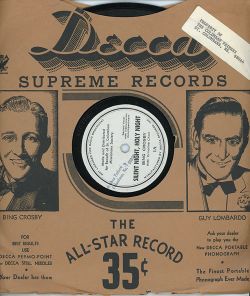
In So Many Words
How was it that Columban priest, Fr. Dick Ranaghan, spurred Bing Crosby into making his first record of Silent Night?
Fr. Ranaghan was already a priest when in 1917 he joined the fledgling organization that soon became known as the Missionary Society of St. Columban. From the outset it was clear that he had a special talent in communications, and so he assisted first in our mission magazine office in Ireland, and then later in doing mission promotion across the U.S. However, when the first group of Columban priests had finished their preparation and were ready to set sail for China in 1920, Fr. Ranaghan was on board with them.

During the years that followed, Fr. Ranaghan became even more keenly aware not just of the unique challenges and opportunities that were present in China, but also of the importance of communicating the Columban mission experience there to family members, supporters and young people in the U.S. and Ireland. With this in mind, he got a movie camera and began recording the life and ministries of his Columban confreres in China. Then, he returned to the U. S. where he edited the materials and composed the storyline to accompany and explain them. Later, in order to record the narration, he approached Crosby Enterprises to request the loan of their sound equipment.
It was there that Fr. Ranaghan encountered Larry and Bing Crosby, who became interested in his novel project. In the course of their conversations, Larry made the seemingly wild suggestion that Bing might provide some songs for the soundtrack. Never a man to miss an opportunity, Fr. Ranaghan pursued the idea and was able to convince them to follow through with it. Consequently, when the first movie about Columban missionaries, "The Cross and the Dragon,†was produced at the end of 1934, it contained Bing Crosby's first ever public rendition of Silent Night and Adeste Fidelis. Then another proposal surfaced: to cut records with these Christmas hymns, which Fr. Dick would sell to the audience at the end of the movie, and use the proceeds for Columban mission. Once again, Bing Crosby was supportive of the proposal, and in the months that followed these records became popular among audiences of parish halls in small towns as well as in big cities. Soon, local radio stations and record stores became interested in this new phenomenon, which led the record company, Decca, to make a commercial recording of Bing Crosby singing these Christmas hymns.
A few years later, at the age of forty-eight, Fr. Ranaghan died tragically in a traffic accident while doing mission promotion. Shortly before his death he wrote: "My picture taking has been an amateur sideline. I have had to build my scenario around what I had.†He had keenly felt the constraints that came from a lack of technical expertise, a shoestring budget, and the large geographical distances within the Columban missionary world. However, his colleagues and those who knew him recognized none of these limitations, but rather saw in Fr. Ranaghan an enthusiasm and commitment that inspired the Chinese people, U.S. parish hall audiences, and Bing Crosby to collaborate generously with Columban missionary endeavors.
Today, over eighty years later, "The Cross and the Dragon" – with Silent Night in the background – still conveys Fr. Ranaghan's missionary zeal.
The Columban Missionaries